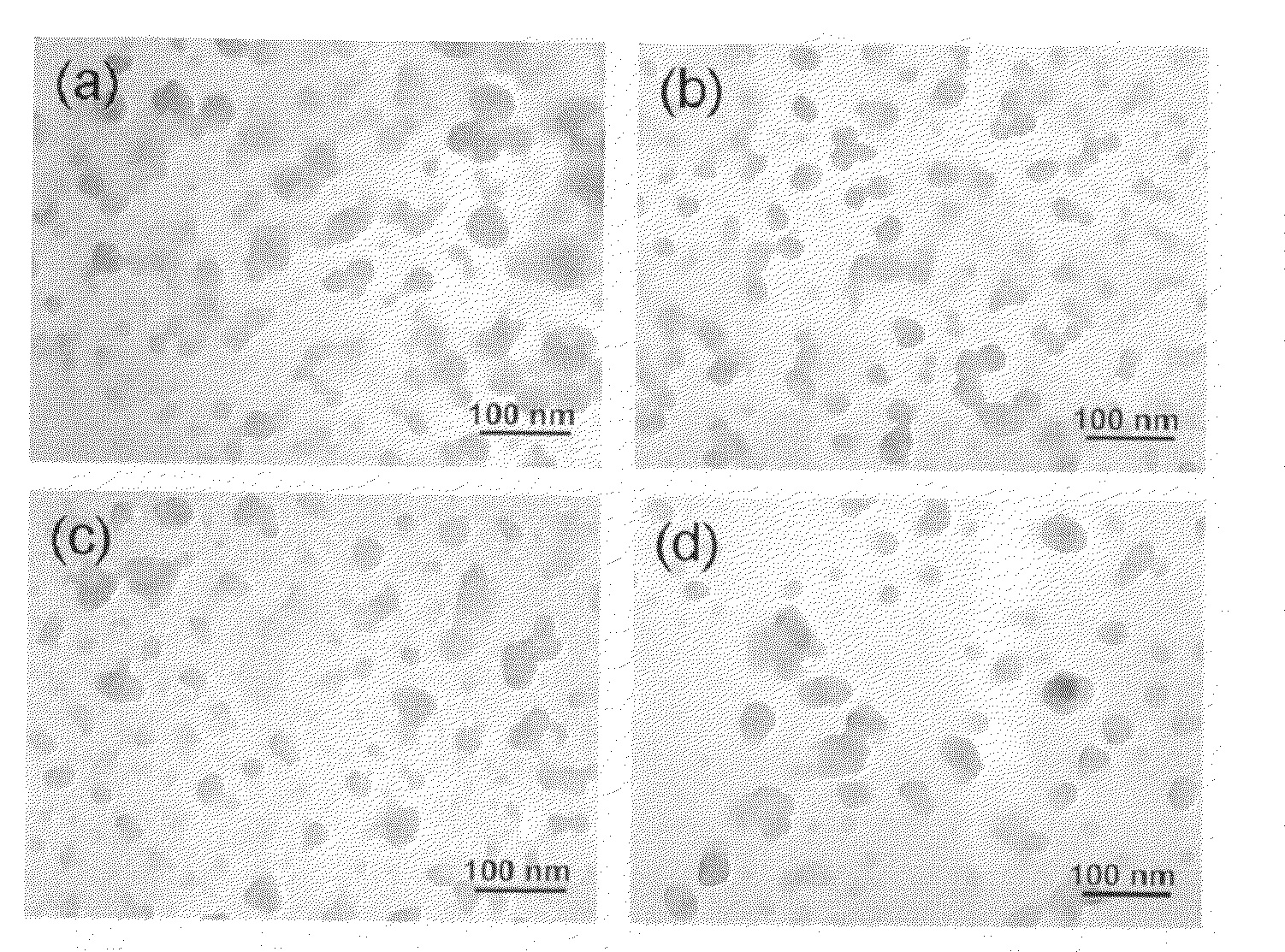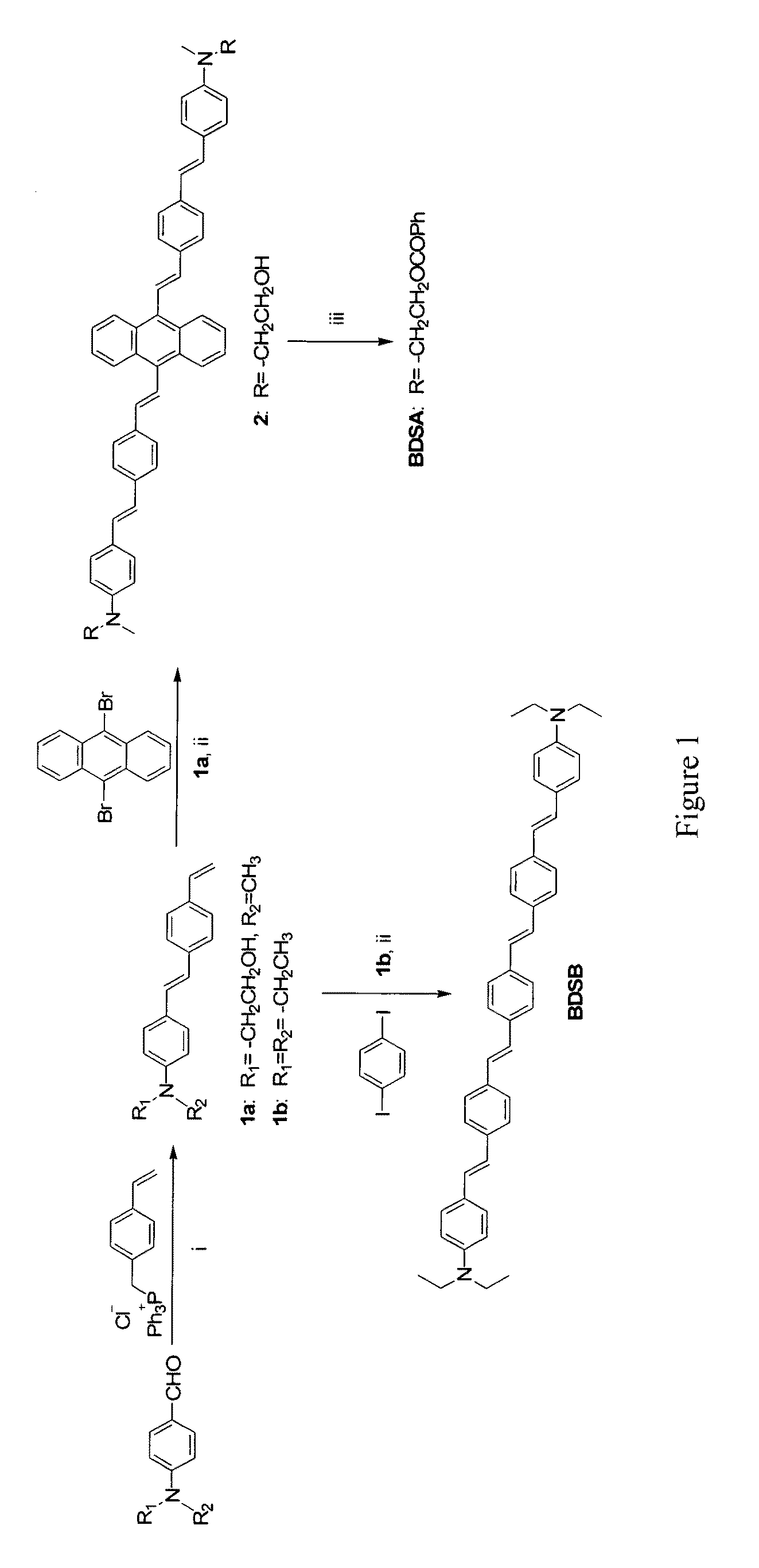Nanoparticles for two-photon activated photodynamic therapy and imaging
a two-photon activated photodynamic therapy and nanoparticle technology, applied in the direction of instruments, cellulosic plastic layered products, silicon compounds, etc., can solve the problems of insufficient amount being delivered to the target tissue, dye encapsulation, and significantly reduced fluorescence quantum yields in water, so as to achieve enhanced behavior
- Summary
- Abstract
- Description
- Claims
- Application Information
AI Technical Summary
Benefits of technology
Problems solved by technology
Method used
Image
Examples
example 1
This Example Describes Synthesis of a TPA Dye
4-(4′-{N-Methyl-N-[2-hydroxyethyl]amino}styryl)styrene (1a)
[0042]Powder sodium t-butoxide (2.4 g, 25 mmol) was added in small portions to a solution of N-methyl-N-(2-hydroxyethyl)-4-aminobenzaldehyde (3.46 g, 19.3 mmol) and 4-vinylbenzyltriphenylphosphonium chloride[14] (8 g, 19.3 mmol) in methanol (30 mL). The reaction mixture was stirred at room temperature for 1 day and filtered to give a pure trans-isomer precipitate selectively. The filtered product was further washed with methanol several times. Yield 2 g (37%). 1 H NMR (300 MHz, DMSO-d6): δ 7.68 (d, 2H, J=8.1 Hz), 7.63-7.57 (m, 4H), 7.32 (d, 1H, J=16.4 Hz), 7.12 (d, 1H, J=16.4 Hz), 6.94-6.85 (m, 3H), 6.00 (d, 1H, J=17.4 Hz), 5.41 (d, 1H, J=11.1 Hz), 3.72 (t, 2H, J=5.7 Hz), 3.60 (t, 2H, J=5.7 Hz), 3.14 (s, 3H).
9,10-Bis(4′-{4″-[N-methyl-N-(2-hydroxyethyl)amino]styryl}styryl)anthracene (2)
[0043]A mixture of 1a (1.2 g, 4.3 mmol), 9,10-dibromoanthracene (0.57 g, 1.7 mmol), Pd(OAc)2 (26 ...
example 2
[0046]The ORMOSIL nanoparticles comprising the TPA dye were prepared as follows. N-Methyl-2-pyrrolidinone (NMP, Aldrich) was used as a hydrophilic solvent. To obtain a clear solution of prepolymerized silica sol, 0.2 g of triethoxyvinylsilane (VTES, Aldrich, 97%) in 2 mL NMP was hydrolyzed and condensed in the presence of 40 μL NH4OH (J. T. Baker, 28.0˜30.0%) at room temperature for 12 h to 1 day, until adding one drop of the resulting solution into excess pure water made white bulk precipitate, without the liquid phase of unreacted VTES or oligomers. After syringe filtering by membrane filter (0.2-μm pore), the sol solution was homogeneously mixed with BDSA or other dyes and additional NMP in a certain ratio. For the study of BDSA optical properties, the mixed solution was prepared such that 6 mg of the total initial feed weight [BDSA+VTES] was dissolved in 0.86 mL of NMP. The compositions (BDSA / [BDSA+VTES]) of 0.5, 5, 25, 50, 75, and 100 wt % were prepared. For other nanoparticles...
example 3
[0049]This example demonstrates the use of the BDSA / ORMOSIL nanoparticles for optical bioimaging. For these studies, Human cervical epitheloid carcinoma cell line (HeLa) was maintained in Dulbecco's modified eagle medium with 10% FBS. To study the uptake and imaging of BDSA / ORMOSIL particles, the cells were plated at approximately 105 cells per 35-mm culture plates (glass bottom plates from MatTek Corporation) and 2 mL of the medium was added. For flow cytometry studies, cells were plated at approximately 2.5×105 cells per 25 cm2 cell culture flasks and 4 mL media was added. These plates and flasks were then placed in an incubator at 37° C. with 5% CO2 (VWR Scientific, model 2400). After 24 hrs of incubation, the cells (about 60% confluency) were rinsed with PBS, and fresh media was added. For imaging experiments, 100 μL of the respective nanoparticle sample was added to 1 mL of the cell culture medium and the medium in each plate was exchanged with the nanoparticle mixed medium. Fo...
PUM
| Property | Measurement | Unit |
|---|---|---|
| Size | aaaaa | aaaaa |
| Size | aaaaa | aaaaa |
| Particle size | aaaaa | aaaaa |
Abstract
Description
Claims
Application Information
 Login to View More
Login to View More - R&D
- Intellectual Property
- Life Sciences
- Materials
- Tech Scout
- Unparalleled Data Quality
- Higher Quality Content
- 60% Fewer Hallucinations
Browse by: Latest US Patents, China's latest patents, Technical Efficacy Thesaurus, Application Domain, Technology Topic, Popular Technical Reports.
© 2025 PatSnap. All rights reserved.Legal|Privacy policy|Modern Slavery Act Transparency Statement|Sitemap|About US| Contact US: help@patsnap.com



